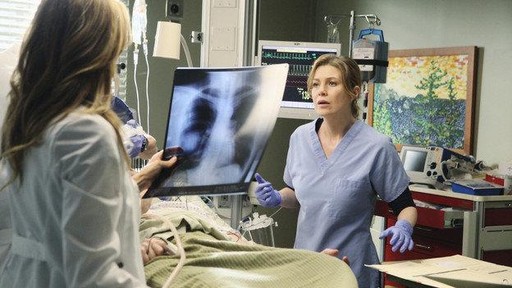
Klebsiella Pneumonia
Apr 29th, 2010
Klebsiella Pneumonia
In Episode 620, Hook, Line, & Sinner, Walter and his son Doug come into Seattle Grace as victims of a crab boat accident. Doug let go of a rope, which sent a crab cage plummeting on top of the deck. But even after our surgeons treat Walter and Doug's injuries, their vitals do not seem to improve—they only get worse. They develop coughs that produce bloody mucus, and their fevers seem to be increasing by the minute. And why?
... Because they contracted an infectious disease that got out of hand while out at sea and living on the boat for months at a time...
So, what the heck did they have again? Kleb-what?
Klebsiella Pneumonia is named for the bacteria that causes it—a type of Gram-negative bacteria that can cause infections such as pneumonia, bloodstream infections, wound or surgical site infections, and meningitis. People prone to infection include patients in healthcare facilities, especially the very sick patients or ones that need devices such as ventilators or IV-catheters. Healthy people generally are not at risk.
But Walter and Doug have contracted a community-acquired form of this pneumonia, which can occur in people who have not been recently hospitalized. Walter and Doug had been exposed to Klebsiella before the accident, and due to living on a crab boat out at sea for months at a time with exhausting work conditions, the father and son do not have the strongest immune systems, which is why it causes such severe symptoms in these otherwise healthy, robust men. Decreased immunity is another common factor in catching the illness. Then, their cases only worsened once they had been injured and hospitalized. And obviously due to the illness being community-acquired, the rest of the boat's crew members will need to be tested since they all share such close quarters.
What are the typical symptoms?
This type of pneumonia presents such as a cold, flu, or any other condition that might damage the defenses of the airways and allow bacteria to infect them. The symptoms do vary and generally overlap with other symptoms of the common cold or flu virus; therefore, this variability makes it more difficult to initially diagnose the pneumonia. People typically think they have an annoying cold that will not go away. But the disease can be life-threatening or fatal if not properly treated. Classic symptoms include:
- Shaking and chills
- Fever
- Cough that produces sputum usually rust-colored (or burnt orange)
- Shortness of breath
- Chest pain worsened by deep breathing or coughing
- Night sweats
And additional symptoms that do not affect every patient:
- Headache
- Loss of appetite
- Excessive sweating or clammy skin
- Confusion in older people
- Excessive fatigue
How does the pneumonia get diagnosed and then treated?
Symptoms and a physical examination can lead physicians in the direction, but confirmation includes a Gram stain and culture.
Unfortunately, Klebsiella organisms have an increasing resistance to multiple antibiotics, and treatment depends on which organ system has been infected. But for severe infections, physicians typically start their patient on a first course of antibiotic therapy for forty-eight to seventy-two hours. And with community-acquired pneumonia, effective treatment includes imipenem and third-generation cephalosporins or quinolones, aggressive ventilation, and supportive care. In total, antibiotic therapy for at least fourteen days is strongly advised.
How did Teddy, a heart surgeon attending, initially miss the diagnosis?
Teddy did not immediately see the Klebsiella because pneumonia can also present as an effusion (fluid build-up in the lungs). On an X-ray, an effusion and blood look the same. Since Walter had suffered so much trauma and a freaking HOOK in his chest, Teddy reasonably assumed that it was bleeding that was not relieved in the first surgery.
For additional information, please visit:
http://www.cdc.gov/ncidod/dhqp/ar_kp.html
In Episode 620, Hook, Line, & Sinner, Walter and his son Doug come into Seattle Grace as victims of a crab boat accident. Doug let go of a rope, which sent a crab cage plummeting on top of the deck. But even after our surgeons treat Walter and Doug's injuries, their vitals do not seem to improve—they only get worse. They develop coughs that produce bloody mucus, and their fevers seem to be increasing by the minute. And why?
... Because they contracted an infectious disease that got out of hand while out at sea and living on the boat for months at a time...
So, what the heck did they have again? Kleb-what?
Klebsiella Pneumonia is named for the bacteria that causes it—a type of Gram-negative bacteria that can cause infections such as pneumonia, bloodstream infections, wound or surgical site infections, and meningitis. People prone to infection include patients in healthcare facilities, especially the very sick patients or ones that need devices such as ventilators or IV-catheters. Healthy people generally are not at risk.
But Walter and Doug have contracted a community-acquired form of this pneumonia, which can occur in people who have not been recently hospitalized. Walter and Doug had been exposed to Klebsiella before the accident, and due to living on a crab boat out at sea for months at a time with exhausting work conditions, the father and son do not have the strongest immune systems, which is why it causes such severe symptoms in these otherwise healthy, robust men. Decreased immunity is another common factor in catching the illness. Then, their cases only worsened once they had been injured and hospitalized. And obviously due to the illness being community-acquired, the rest of the boat's crew members will need to be tested since they all share such close quarters.
What are the typical symptoms?
This type of pneumonia presents such as a cold, flu, or any other condition that might damage the defenses of the airways and allow bacteria to infect them. The symptoms do vary and generally overlap with other symptoms of the common cold or flu virus; therefore, this variability makes it more difficult to initially diagnose the pneumonia. People typically think they have an annoying cold that will not go away. But the disease can be life-threatening or fatal if not properly treated. Classic symptoms include:
- Shaking and chills
- Fever
- Cough that produces sputum usually rust-colored (or burnt orange)
- Shortness of breath
- Chest pain worsened by deep breathing or coughing
- Night sweats
And additional symptoms that do not affect every patient:
- Headache
- Loss of appetite
- Excessive sweating or clammy skin
- Confusion in older people
- Excessive fatigue
How does the pneumonia get diagnosed and then treated?
Symptoms and a physical examination can lead physicians in the direction, but confirmation includes a Gram stain and culture.
Unfortunately, Klebsiella organisms have an increasing resistance to multiple antibiotics, and treatment depends on which organ system has been infected. But for severe infections, physicians typically start their patient on a first course of antibiotic therapy for forty-eight to seventy-two hours. And with community-acquired pneumonia, effective treatment includes imipenem and third-generation cephalosporins or quinolones, aggressive ventilation, and supportive care. In total, antibiotic therapy for at least fourteen days is strongly advised.
How did Teddy, a heart surgeon attending, initially miss the diagnosis?
Teddy did not immediately see the Klebsiella because pneumonia can also present as an effusion (fluid build-up in the lungs). On an X-ray, an effusion and blood look the same. Since Walter had suffered so much trauma and a freaking HOOK in his chest, Teddy reasonably assumed that it was bleeding that was not relieved in the first surgery.
For additional information, please visit:
http://www.cdc.gov/ncidod/dhqp/ar_kp.html



